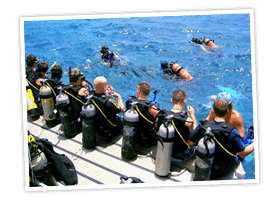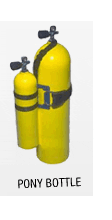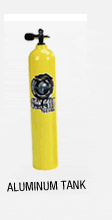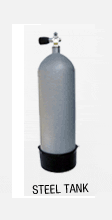Dive Tanks Buying Guide
« Back to Buying Guide Index
Getting Your Own Tank
Most scuba divers, especially new and intermediate divers, rent their tanks. Renting your tanks leaves the burden of maintenance on the dive rental shop; the drawback is you run the risk of the shop being out of rental tanks, especially on popular dive weekends. If you're a serious diver who is ready to purchase your own tanks, you have some decisions to make:
Steel vs. Aluminum, Tank Size, High-Pressure vs. Low-Pressure and DIN vs. Yoke
Steel vs. Aluminum
Scuba tanks are made out of either aluminum or steel. Aluminum tanks are much lighter and less expensive than their steel counterparts. The drawback to aluminum tanks is they are very prone to showing signs of damage, including dings and dents. Steel tanks, while being heavier and more expensive than aluminum tanks, are incredibly tough and tend to have a longer lifespan because of steel's inherit durability. One important note about steel tanks is they can develop rust, so regular maintenance and proper care are crucial.
Steel tanks have been used since diving with tanks was a possibility. As scuba evolved as a sport, aluminum was introduced as a tank material. Because aluminum is softer than steel, the walls of aluminum tanks are thicker than the walls of steel tanks. Therefore, aluminum tanks are a bit larger than their steel counterparts.



Regardless of which material the tank is made from, you'll need to take its buoyancy into consideration when determining how much weight you need on your dives. Most rental tanks are aluminum, so you are probably most familiar with aluminum tanks and how they affect your buoyancy.
It is also important to note that because air has weight, a full tank is heavier than an empty dive tank. Therefore, make sure you wear enough weight to compensate for the additional buoyancy your tank will gain as you breathe its contents.tents.
In the water, an empty steel tank typically weighs about three pounds (negative) and an empty aluminum tank is about 2-4 pounds positively buoyant. This means you'll need to wear more weight when diving with an aluminum tank than when diving with a steel tank. If you've figured out your ideal weight when diving with an aluminum tank, you can typically shed a couple of those pounds if you use a steel tank.
High Pressure vs. Low Pressure
If you've decided steel tanks are your preferred tank choice, you must now decide between high-pressure and low-pressure tanks. A standard aluminum 80 low-pressure tank is 26 inches in length; a standard steel 100 high-pressure tank is only 24 inches long. Two inches may not seem like much, but it is quite a significant difference when the tank is on your back.
High-pressure tanks are smaller than the low-pressure tanks and they contain a greater amount of air. Before thinking that a high-pressure tank is a no-brainer decision, know that high-pressure tanks also require a regulator set up for DIN. If your regulator has a Yoke setup, you'll need to get an adapter to con- vert your Yoke 1st stage to a DIN 1st stage.
Another important note about high-pressure versus low-pressure tanks is service. Because high-pressure tanks are subjected to greater amounts of pressure than are low-pressure tanks, they typically require more frequent servicing and part replacement, especially the valves and O-rings. Because their parts wear out at a faster rate, high-pressure steel tanks are more likely to fail their hydro inspection than are low- pressure steel tanks.
Tank Size
The holding capacity of scuba tanks is measured in pressurized cubic feet. Most recreational divers find that an 80 to 100-cubic-foot tank is sufficient for their underwater breathing needs. The most commonly- used rental tank is an aluminum 80, meaning a tank that holds 80 cubic feet of air and is made from aluminum.
In addition to a main tank, it is always a good idea to carry a spare tank, or a pony bottle. Pony tanks are small (40-cubic-feet or smaller) tanks that are used in case of a problem with a main tank, either yours or your buddy's. If you carry a pony bottle, it needs its own regulator (1st & 2nd stage).
DIN vs. Yoke
There are two types of coupling fittings that are used to attach a regulator's 1st stage to the tank: DIN and Yoke.
Yoke couplings are more commonly found world wide and are almost always used by the ever-popular aluminum 80 tanks. DIN fittings are safer than yoke fittings and are the only fitting that can couple with high-pressure tanks. The advantage of DIN fittings is that they screw into the tank valve and trap the high- pressure o-ring so it cannot protrude, like can occasionally happen when using a yoke fitting.
A DIN-style tank can be equipped with a yoke adapter for the purposes of filling the tank. Likewise, a yoke- style tanks can be equipped with a separate DIN adapter for the purposes of filling the tank (see picture below). Regulators can also be equipped with adapters that replaces the yoke portion of the 1st stage on a semi-permanent basis. DIN adaptors should be installed by a qualified scuba repair technician at a full- service scuba shop. This option is preferred if you frequently use DIN valve tanks.
Dive Tank Accessories:
-

Tank Lock
A tank lock makes attaching your tank to your BCD an effortless task. It also reduces the risk of your tank slipping once you enter the water.
-

Tank Banger
A convenient way to get your dive buddy's attention while at depth is using a tank banger, which is a plastic bead on a piece of rubber tubing that slips over the tank.
-

Tank Holder
Use a tank holder to keep your tank from rolling around in your car or while in storage.
